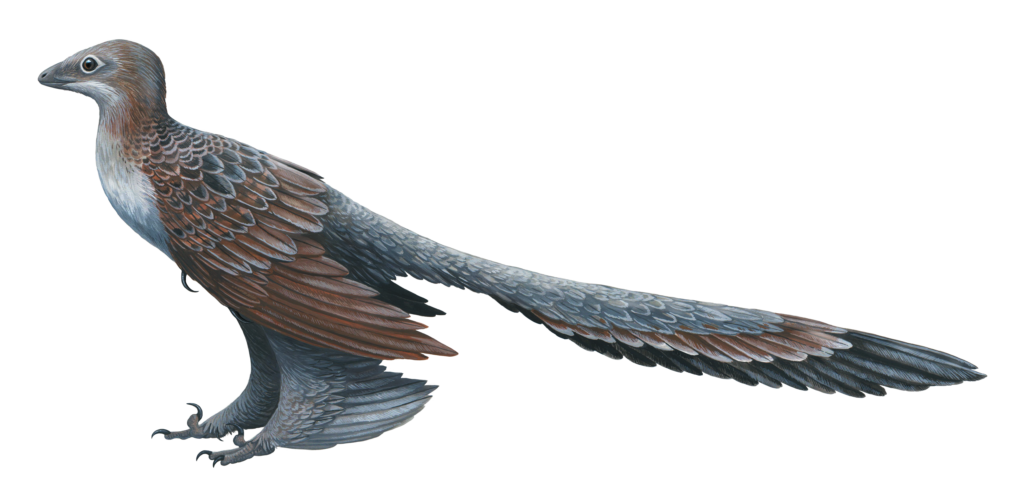
Ironically, it was while watching a show on YouTube about raptors that something so obvious occurred to me. Parallel evolution is well-known. What happens when it simply keeps going? Also as corollaries; why doesn’t parallel evolution go further in so many cases?
This is where Coelophysis comes in. The famous “first dinosaur” was way ahead of its time as a morphological pattern. To be precise, it was about 228 million years ahead in some respects. It’s a primitive pattern in comparison to modern versions. It’s also the baseline pattern for theropods, birds, and that core pattern fills and has filled a lot of ecological niches.
It’s a biped. It has a (sort of) avian configuration. It’s lightweight and clearly agile. It was a highly successful, ultra-competitive species in its time, the Triassic.
To clarify the obvious – This morphology has persisted and diversified like no other. It’s so routinely in the mix of animals on Earth that it’s almost absurd, statistically. Animals not directly related to Coelophysis evolved parallel shapes and locomotion on an almost routine basis.
The raptors, in particular, were very fast-moving and agile. Of all the non-avian dinosaurs, these are the most avian in many ways. The morphology of Coelophysis adapted and improved, but it’s still the same basic blueprint.
…Hence the need for a bit of digging around in the “discretionary” evolution of Coelophysis when it comes to the raptors.
Being bipedal allowed for a type of locomotion perfect for predation. Prey animals, usually quadrupeds, originally didn’t have this type of movement or acceleration. When some prey adopted bipedalism, they still didn’t have the agility or the speed, although some came close.
The big theropods were also at an obvious disadvantage for speed. I don’t buy the theory that T. Rex “ran like a chicken”. If you’ve ever tried to catch a chicken, they’re not all that clumsy; but they could turn or maneuver as fast as a raptor. So most raptors weren’t at any great risk from easily-outrunnable big predators. A survival trait inherited from Coelophysis, built in by evolution.
Parallel evolution is actually pretty common. A lot of examples are routinely trotted out and underdeveloped as arguments, but there’s a question or so to be answered:
At what point does parallel evolution diversify to the point that it doesn’t work? For example; there are no parallels to the elasmosaurs, or other long-necked predators. Sharks diversified a lot over the years, but reverted to the archetype morphology. Crocodiles relentlessly retain their core morphology, despite any number of variations. Monitor lizards didn’t do any sort of parallel evolution, but simply amplified their archetypal form in multiple ways. From this perspective, parallel evolution seems to be a closed circuit; you can go back to square one, or die out.
Insects have multiple evolutionary facets, but the most advanced insects, Hymenoptera, seem to stick to baseline evolution within the blueprint, not outside it. They don’t seem to have many cases of parallel evolution.
…Which is what makes the raptors unique. They didn’t just evolve in parallel, but gave rise to a whole new class – Birds. This is parallel evolution as a true unmitigated success. No other class of animal has done that. Even humans are still basically anthropoids, evolved into hominids. That’s not as huge a step as creating a new class of animal.
If you look at the video above, despite the post-hypnotic delivery that makes so many paleo documentaries soporific, you’ll notice a few things:
- Raptors are extremely adaptable. Their sheer range of specializations is fascinating. Their sizes varied enormously, maintaining a weight-to-power ratio for hunting and managing nutrition. The big theropods were at a serious disadvantage here with massive dietary requirements.
- The raptors were obviously endothermic, so they were much more active than reptiles and amphibians, and probably other dinosaurs. Their feathers and proto-feathers would have improved energy conservation and other efficiencies. These factors are common in all raptors.
- Evolution obviously had a few good practical ideas as the raptors evolved. The various types of vestigial wings may have served a very useful purpose other than body temperature.
- They could mix running speed and agility with gliding capacity to manage terrain and maintain speed with minimal energy expenditure. They would have been able to dodge and glide over and around obstacles and outmaneuver prey. They could also maintain a chase with less effort. This is something their prey definitely couldn’t do. It would also have given them a big advantage over competing predators.
The four-winged Dromaeosaurs are obvious lineal descendants of a long line of winged raptors. This is an intriguing morphology. According to theory, they “may have been capable of clumsy powered flight over short distances.”

From the look of the feathers, and the fact that these animals obviously had plenty of muscle power, maybe they could do a lot better than that. Depending on mass, they could clearly glide, and at least do some powered flying. Add fast running, and they would have been very effective in forest environments.
OK. The obvious needs to get a word in here. So why were there no more four-winged animals? Did parallel evolution change its mind, or were low-mass birds the better option? Maybe parallel evolution takes sidesteps when the returns on energy are better?
This is one of my theories. The amount of available energy in an ecosystem defines the life in that system. Energy efficiency is therefore a prerequisite to defining the success or failure of a species.
Birds couldn’t be dromaeosaurs. They didn’t need to be. Flight was much faster than running. The big heavy jaws turned into beaks with hooks and without teeth. Parallel evolution evolved itself into normal evolution.
We now, mercifully, get to the points of this article.
The raptor blueprint is one of the few cases of one class of animal giving rise directly to a whole new class entirely through evolutionary processes over a very long time frame.
The raptor evolutionary process meticulously stuck to the principles of efficiency, particularly energy efficiency and developing specific advantages. This is textbook stuff.
Now, let’s get brutal:
- Is it possible to predict evolutionary outcomes on this scale?
- Over what time frame(s)?
- What about environmental factors?
- Can you predict, or retrofit, an ecology to match the evolutionary outcomes?
If we’re going to start developing artificial species, or resurrecting old species, we’d better know what we’re talking about. Biology is just now waking up as a science. We’re at the point where we more or less understand the past. We may find that anything and everything from micro to macro biology needs to be understood before it becomes either a triumph or a catastrophe.
We have precisely one blueprint to work with.
